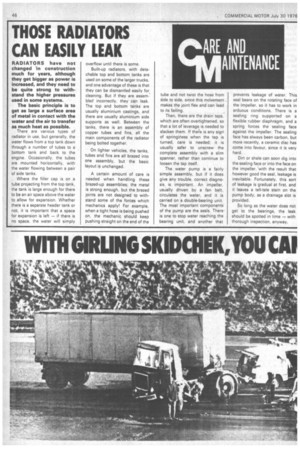THOSE RADIATORS CAN EASILY LEAK
Page 48

If you've noticed an error in this article please click here to report it so we can fix it.
RADIATORS have not changed in construction much for years, although they get bigger as power is increased, and they need to be quite strong to withstand the higher pressures used in some systems.
The basic principle is to get as large a surface area of metal in contact with the water and the air to transfer as much heat as possible.
There are various types of radiator in use, but generally, the water flows from a top tank down through a number of tubes to a bottom tank and back to the engine. Occasionally, the tubes are mounted horizontally, with the water flowing between a pair of side tanks.
Where the filler cap is on a tube projecting from the top tank, the tank is large enough for there to be an air space above the water to allow for expansion. Whether there is a separate header tank or not, it is important that a space for expansion is left -if there is no space, the water will simply overflow until there is some.
Built-up radiators, with detachable top and bottom tanks are used on some of the larger trucks, and one advantage of these is that they can be dismantled easily for. cleaning. But if they are assembled incorrectly, they can leak. The top and bottom tanks are usually aluminium castings, and there are usually aluminium side supports as well. Between the tanks, there is an assembly of copper tubes and fins, all the main components of the radiator being bolted together.
On lighter vehicles, the tanks, tubes and fins are all brazed into one assembly, but the basic layout is unchanged.
A certain amount of care is needed when handling these brazed-up assemblies; the metal is strong enough, but the brazed joints are not designed to withstand some of the forces which mechanics apply! For example, when a tight hose is being pushed on, the mechanic should keep pushing straight on the end of the tube and not twist the hose from Side to side, since this mdvement . makes the joint flex and can lead to its failing.
Then, there are the drain taps, which are often overtightened, so that a lot of leverage is needed to slacken them. If thee is any sign of springiness when the tap is turned, care is needed; it is usually safer to unscrew the complete assembly with a slim spanner, rather than continue to loosen the tap itself.
The water pump is a fairly simple assembly, but if it does give any trouble, correct diagnosis is important. An impeller, usually driven by a fan belt, circulates the water, and it is carried on a double-bearing unit. The most important components of the pump are the seals. There is one to stop water reaching the bearing unit, and another that prevents leakage of water. This seal bears on the rotating face of the impeller, so it has to work in arduous conditions. There is a sealing ring supported on a flexible rubber diaphragm, and a spring forces the sealing face against the impeller. The sealing face has always been carbon, but more recently, a ceramic disc has come into favour, since it is very hard.
Dirt or shale can soon dig into the sealing face or into the face on the impeller, 'with the result that however good the seal, leakage is inevitable. Fortunately, this sort of leakage is gradual at first, and it leaves a tell-tale stain on the pump body, as a drainage slot is provided, So long as the water does not get to the bearings, the leak should be spotted in time -with thorough inspection, anyway.




















































































